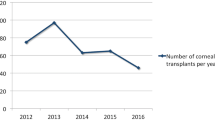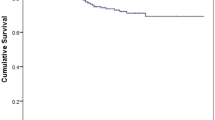Abstract
Background
To evaluate the trends in indications for penetrating keratoplasty (PKP) in Homburg/Saar between 2001 and 2010.
Methods
Retrospective review of 1,200 corneal buttons which underwent PKP that were performed between 2001 and 2010 at the Department of Ophthalmology of Saarland University Hospital, Germany. Indications were classified into eight different groups following histological analysis: keratoconus, Fuchs’ dystrophy, bullous keratopathy, corneal scars, keratitis, regraft, corneal dystrophy other than Fuchs’ dystrophy, and other diagnoses. Two different time periods (between 2001–2005 and between 2006–2010) were analyzed.
Results
Keratoconus (25.5 %) was the most common indication for PKP in our study, followed by Fuchs’ dystrophy (21.2 %), bullous keratopathy (14.6 %), corneal scars (14.4 %), keratitis (13.0 %), regraft (7.0 %), non-Fuchs’ dystrophies (2.1 %), and other diagnoses (2.3 %). Comparing the two different time periods, a trend of significantly increasing frequency of keratoconus and Fuchs’ dystrophy, and a decreasing frequency of corneal scars, were found as indications for PKP in our study.
Conclusions
Keratoconus was the leading indication for PKP in our series, and had a significantly increasing trend from 2001–2005 to 2006–2010. The percentage of patients with Fuchs’ dystrophy increased, and became the second most common indication for PKP, while the number of PKPs for corneal scars decreased during the last 5 years in our institution.

Similar content being viewed by others
References
Lois N, Kowal VO, Cohen EJ, Rapuano CJ, Gault JA, Raber IM, Laibson PR (1997) Indications for penetrating keratoplasty and associated procedures, 1989–1995. Cornea 16:623–629
Ghosheh FR, Cremona F, Ayres BD, Hammersmith KM, Cohen EJ, Raber IM, Laibson PR, Rapuano CJ (2008) Indications for penetrating keratoplasty and associated procedures, 2001–2005. Eye Contact Lens 34:211–214
Dobbins KR, Price FW Jr, Whitson WE (2000) Trends in the indications for penetrating keratoplasty in the midwestern United States. Cornea 19:813–816
Szentmáry N, Bausz M, Tóth J, Süveges I (2004) Eleven years of corneal transplantation at the 1st department of ophthalmology of Semmelweis University (1992–2003). Szemészet 141:387–391
Siganos CS, Tsiklis NS, Miltsakakis DG, Georgiadis NS, Georgiadou IN, Kymionis GD, Pallikaris IG (2010) Changing indications for penetrating keratoplasty in Greece, 1982–2006: a multicenter study. Cornea 29:372–374
Dandona L, Ragu K, Janarthanan M, Naduvilath TJ, Shenoy R, Rao GN (1997) Indications for penetrating keratoplasty in India. Indian J Ophthalmol 45:163–168
Xie L, Song Z, Zhao J, Shi W, Wang F (2007) Indications for penetrating keratoplasty in north China. Cornea 26:1070–1073
Cursiefen C, Küchle M, Naumann GOH (1998) Changing indications for penetrating keratoplasty: histopathology of 1,250 corneal buttons. Cornea 17:468–470
Sektion Kornea in der DOG (2011) German Keratoplasty Registry 2010
Kim MH, Chung TY, Chung ES (2012) A retrospective contralateral study comparing deep anterior lamellar keratoplasty with penetrating keratoplasty. Cornea May 10 [Epub ahead of print]. doi:10.1097/ICO.0b013e318254be4e
Tourtas T, Laaser K, Bachmann BO, Cursiefen C, Kruse FE (2012) Descemet membrane endothelial keratoplasty versus Descemet stripping automated endothelial keratoplasty. Am J Ophthalmol 153:1082–1090
Lombardo M, Lombardo G, Friend DJ, Serrao S, Terry MA (2009) Long-term anterior and posterior topographic analysis of the cornea after deep lamellar endothelial keratoplasty. Cornea 28:408–415
Brady SE, Rapuano CJ, Arentsen JJ, Cohen EJ, Laibson PR (1989) Clinical indications for and procedures associated with penetrating keratoplasty, 1983–1988. Am J Ophthalmol 108:118–122
Waring GO 3rd (1989) The 50-year epidemic of pseudophakic corneal edema. Arch Ophthalmol 107:657–659
Legeais JM, Parc C, d'Hermies F, Pouliquen Y, Renard G (2001) Nineteen years of penetrating keratoplasty in the Hotel-Dieu hospital in Paris. Cornea 20:603–606
Fasolo A, Frigo AC, Bohm E, Genisi C, Rama P, Spadea L, Mastropirro B, Fornea M, Ponzin D, Grigoletto F (2006) The CORTES study: corneal transplant indications and graft survival in an Italian cohort of patients. Cornea 25:507–515
Edwards M, Clover GM, Brookes N, Pendergrast D, Chaulk J, McGhee CN (2002) Indications for corneal transplantation in New Zealand: 1991–1999. Cornea 21:152–155
Zhang C, Xu J (2005) Indications for penetrating keratoplasty in East China, 1994–2003. Graefes Arch Clin Exp Ophthalmol 243:1005–1009
Sony P, Sharma N, Sen S, Vajpayee RB (2005) Indications of penetrating keratoplasty in northern India. Cornea 24:989–991
Seitz B, Langenbucher A, Kus MM, Küchle M, Naumann GO (1999) Nonmechanical corneal trephination with the excimer laser improves the outcome after penetrating keratoplasty. Ophthalmology 106:1156–1164
Al-Yousuf N, Mavrikakis I, Mavrikakis E, Daya SM (2004) Penetrating keratoplasty: indications over a 10 year period. Br J Ophthalmol 88:998–1001
Chen WL, Hu FR, Wang IJ (2001) Changing indications for penetrating keratoplasty in Taiwan from 1987 to 1999. Cornea 20:141–144
Maeno A, Naor J, Lee HM, Hunter WS, Rootman DS (2000) Three decades of corneal transplantation: indications and patient characteristics. Cornea 19:7–11
Módis L Jr, Szalai E, Facskó A, Fodor M, Komár T, Berta A (2011) Corneal transplantation in Hungary (1946–2009). Clin Exp Ophthalmol 39:520–529
Yahalom C, Mechoulam H, Solomon A, Raiskup FD, Peer J, Frucht-Pery J (2005) Forty years of changing indications in penetrating keratoplasty in Israel. Cornea 24:256–258
Acknowledgment
We thank the China Scholarship Council (CSC) for support of the author’s study (J Wang), and the Alexander von Humboldt Foundation for supporting the work of Dr. N. Szentmáry at the Department of Ophthalmology of Saarland University, Homburg/Saar, Germany.
Author information
Authors and Affiliations
Corresponding author
Rights and permissions
About this article
Cite this article
Wang, J., Hasenfus, A., Schirra, F. et al. Changing indications for penetrating keratoplasty in Homburg/Saar from 2001 to 2010—histopathology of 1,200 corneal buttons. Graefes Arch Clin Exp Ophthalmol 251, 797–802 (2013). https://doi.org/10.1007/s00417-012-2117-2
Received:
Revised:
Accepted:
Published:
Issue Date:
DOI: https://doi.org/10.1007/s00417-012-2117-2




